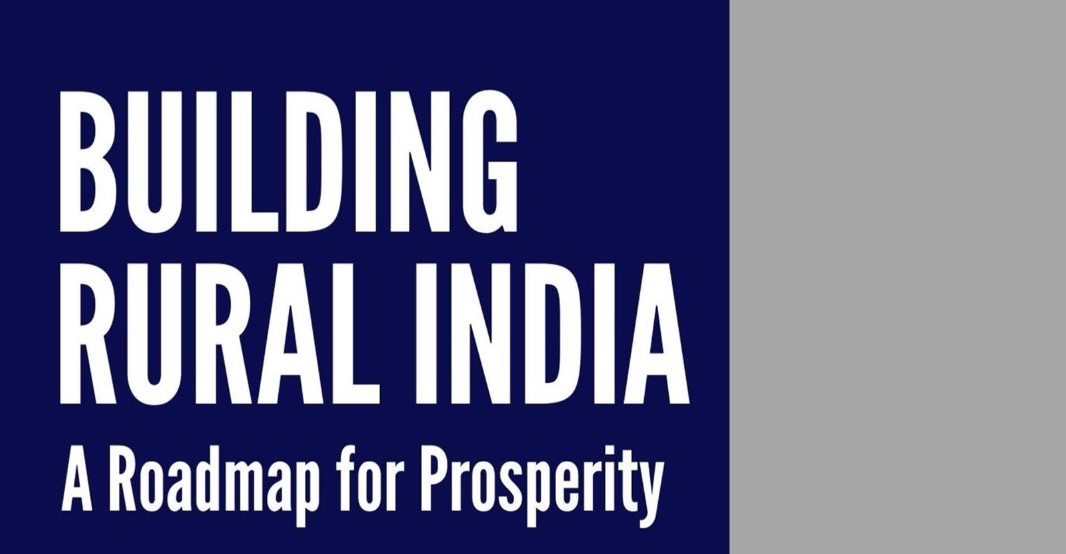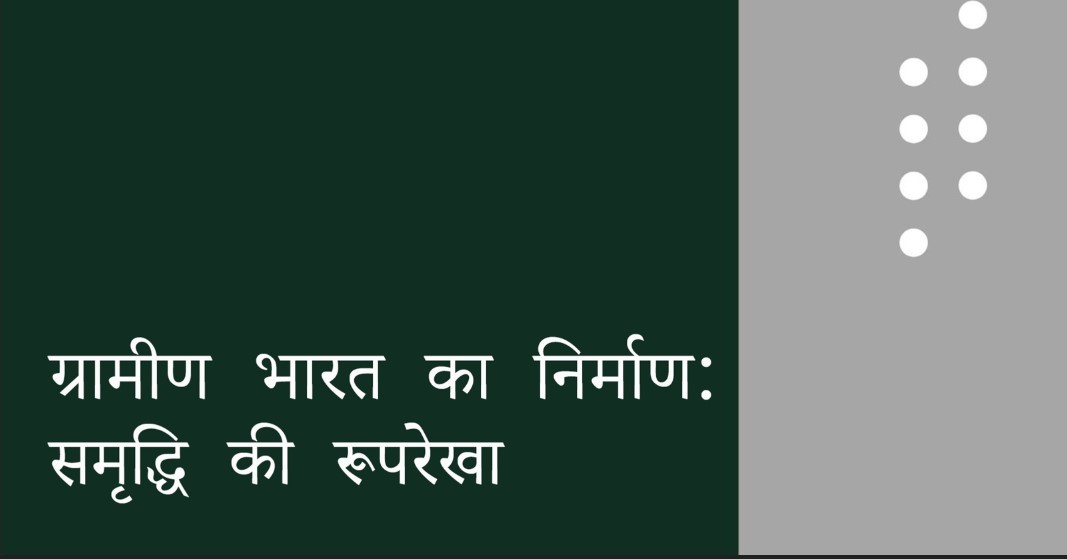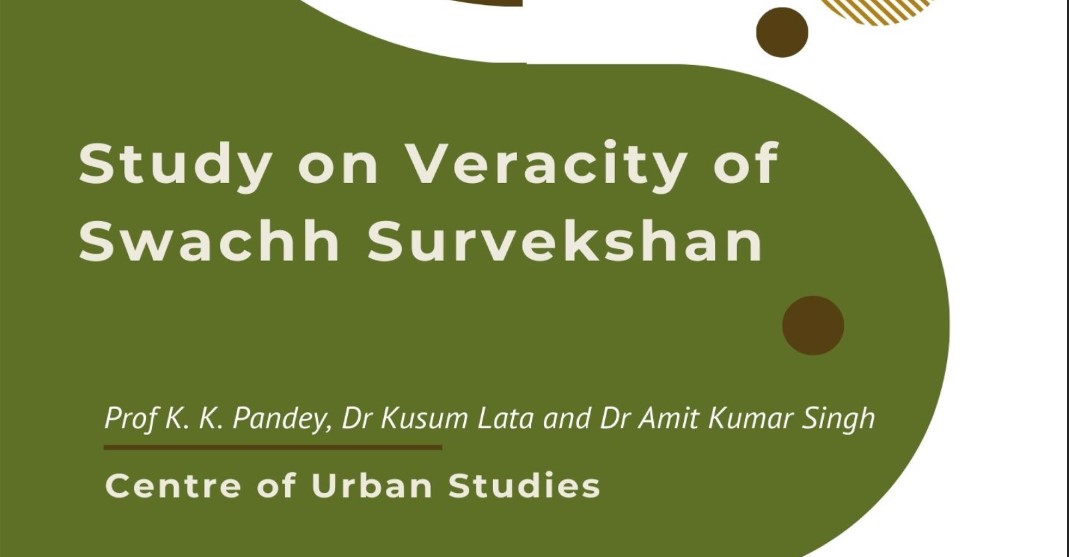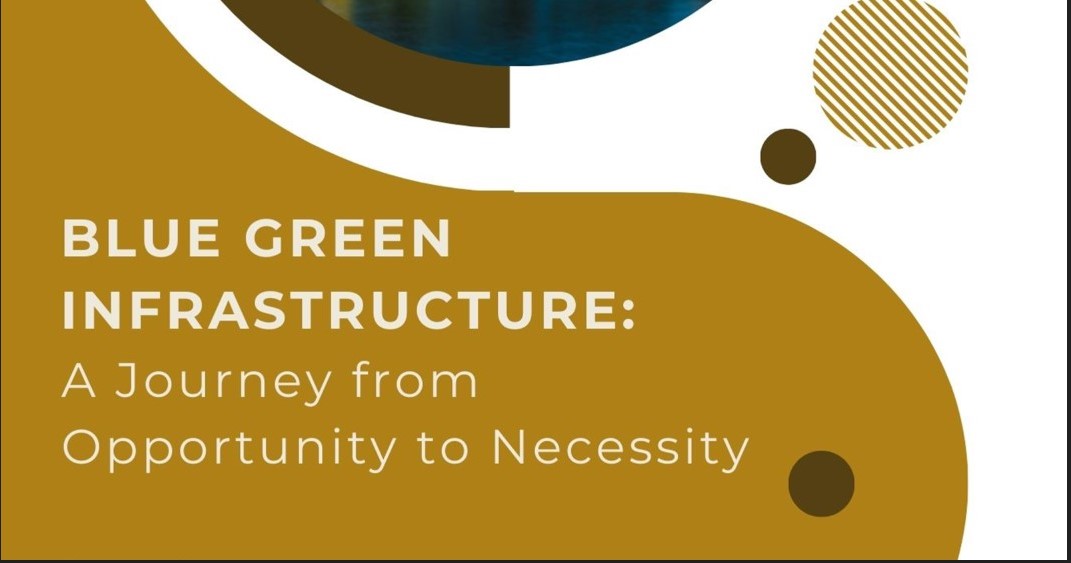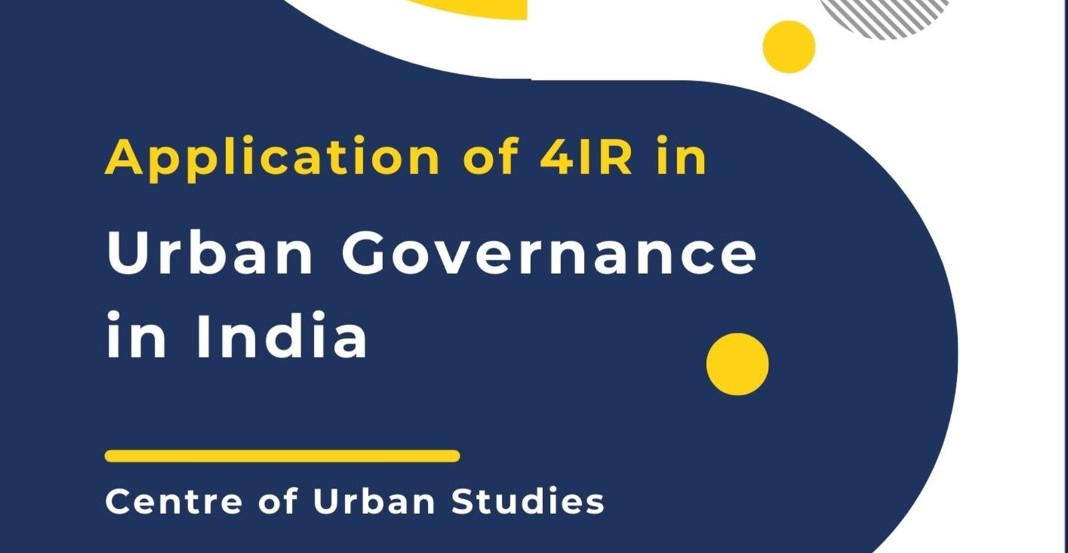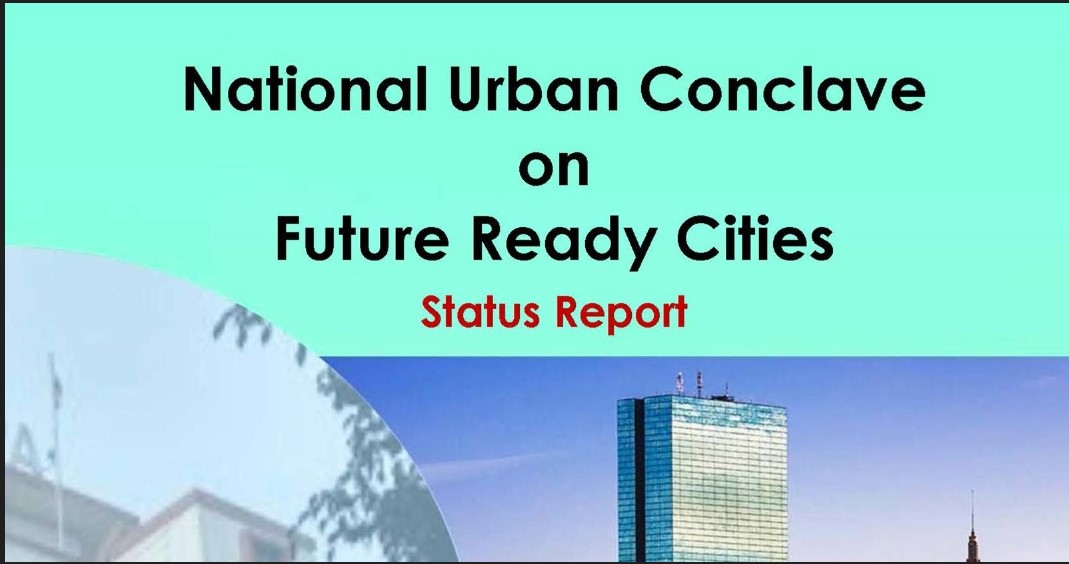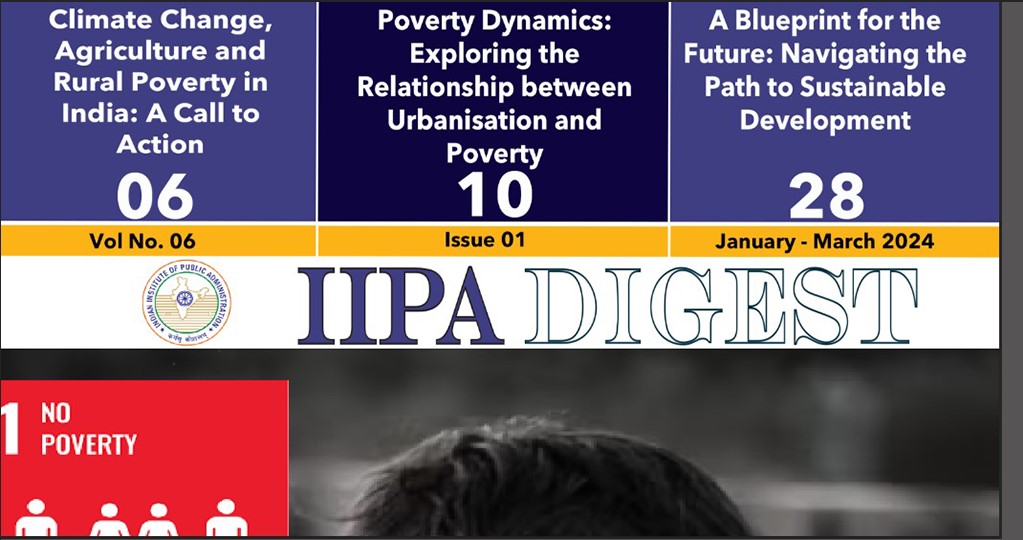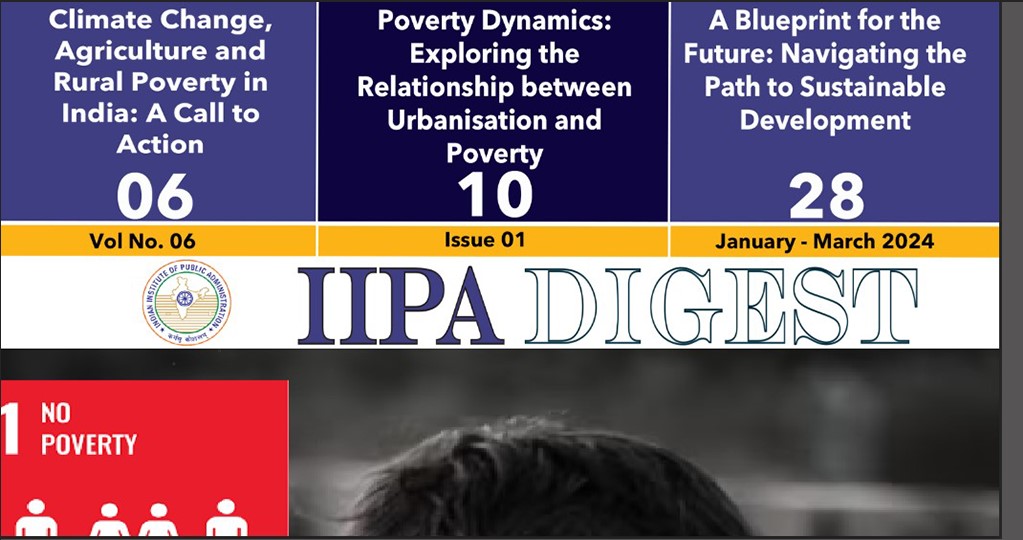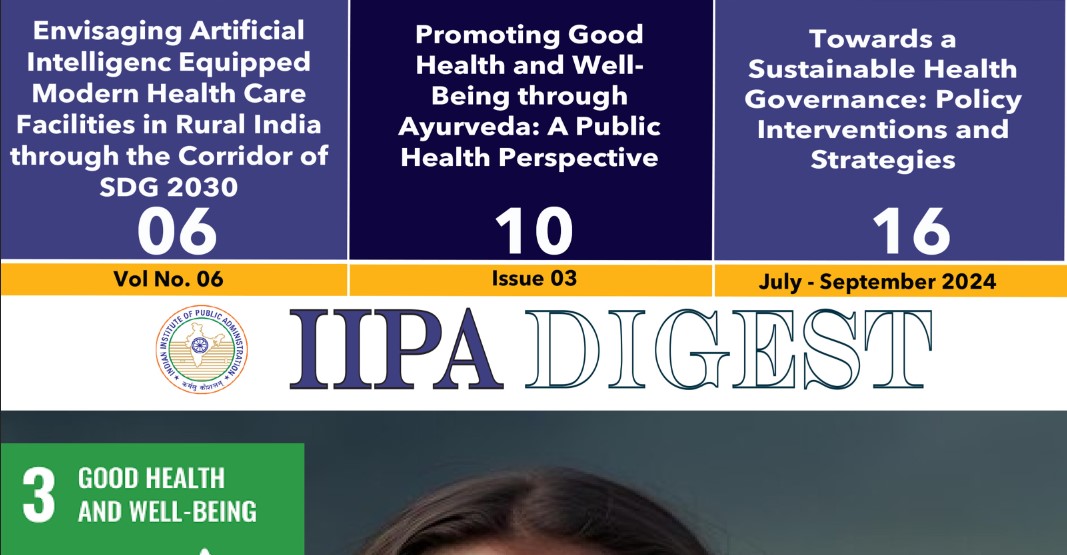People Centric Government-Village Republic, Ease of living and Jan Bhagidaari
Abstract
Panchayati Raj in India is as old as Indian civilisation. Its history goes back to the Vedic times, and according to some, even pre-Vedic times. To understand Indian polity and Indian culture, one has to understand the nature and functions of Village Panchayats. Like the joint family system, Village Panchayats survived all ups and downs until the British takeover of India in the nineteenth century. Even during the British era, they continued to function informally and saved the Indian society from disintegration. By drawing the village into the mainstream of national awakening, Gandhi played a unique role in Indian history. Without the awakening of rural India under his leadership, the economic growth and social development that followed India's achievement of freedom would have been inconceivable. After gaining independence, one of the priority concerns of the government is to revive the Village Panchayats. Today, the panchayats have come to play a major role in rural reconstruction. This paper traces the role of panchayats in the provision of services in rural areas and community mobilization for development.
Keywords: village republic, community participation, panchayats, eGramSwaraj
Introduction
As early as 1936, Mahatma Gandhi remarked, "I would say that if the village perishes, India will perish too." He added, "I have believed and repeated times without number that India is to be found not in the few cities but in its 7 00,000 villages. Perhaps it was only Gandhi who understood the real India best. His role was crucial in awakening the most dormant and stagnant sector of Indian society, viz., the Indian village. By drawing the village into the mainstream of national awakening, Gandhi played a unique role in Indian history. Without the awakening of rural India under his leadership, the economic growth and social development that followed India's achievement of freedom would have been inconceivable.
Gandhi's philosophy offers a practical way to a peaceful social revolution to improve the quality of life. His immediate concern was the Indian masses, especially in the countryside. Gandhiji was of the view that the Indian problem was not merely political or economic but many-sided. People needed courage and a sense of self-respect to enable themselves to come out of the slavish mentality developed over centuries of bondage. In his view, if these conditions were to be changed, politics, education, social reform, economy, and technology had to suit the genius of the society.
Gandhi, therefore, devoted himself completely to the cause of village reconstruction. He tried to uplift the standard and quality of rural life through the active participation of people themselves. It was easy for the masses to understand him better because he spoke in their language and lived like them a life of utter simplicity, and succeeded in enlisting their participation in the struggle for freedom.
Gandhiji said my idea of village Swaraj is that it is a complete republic, independent of its neighbours for its vital wants and yet interdependent for many others in which dependence is necessary. Thus, every village's first concern will be to grow its food crops and cotton for its cloth. It should have a reserve for its cattle, recreation, and a playground for adults and children. Then, if there is more land available, it will grow useful money crops, thus excluding ganja, tobacco, opium, and the like.
The village will maintain a village theatre, school, and public hall. It will have its waterworks, ensuring a clean water supply. This can be done through controlled wells or tanks. Education will be compulsory up to the final basic course. As far as possible, every activity will be conducted on a co-operative basis. There will be no castes such as we have today with their graded untouchability.
The villagers should develop such a high degree of skill that articles prepared by them should command a ready market outside. When our villages are fully developed, there will be no dearth in them of men with a high degree of skill and artistic talent. There will be village poets, village artists, village architects, linguists, and research workers. In short, there will be nothing in life worth having that will not be had in the villages. Today, the villages are dung heaps. Tomorrow they will be like tiny gardens of Eden where dwell highly intelligent folk whom no one can deceive or exploit.
Village Republic or Panchayat
The reconstruction of the villages along these lines should begin now. The reconstruction of the villages should not be organized on a temporary but permanent basis. He said independence must begin at the bottom. Thus, every village will be a Republic or Panchayat having full powers. It follows, therefore, that every village has to be self-sustained and capable of managing its affairs even to the extent of defending itself against the whole world. It will be trained and prepared to perish in its attempt to defend itself against any onslaught from without. Thus, ultimately, it is the individual who is the unit. This does not exclude dependence on and willing help from neighbours or from the world. It will be free and voluntary play of mutual forces. Such a society is necessarily highly cultured, in which every man and woman knows what he or she wants and, what is more, knows that no one should want anything that others cannot have with equal labour.
When panchayat raj is established, public opinion will do what violence can never do. The present power of the zamindars, the capitalists, and the rajas can hold sway so long as the common people do not realize their strength. If the people do not cooperate with the evil of zamindari or capitalism, it must die of inanition. In Panchayat Raj, only the panchayat will be obeyed, and the panchayat can only work through the law of their making.
Gram Swaraj
Gandhi's Gram Swaraj was not the resurrection of the old village but the formation of fresh independent units of villages having a self-sufficient economy. He spelt out the political and economic relations that ought to exist in the village. For him, Man was supreme. The end to be sought is human happiness combined with full mental and moral growth. Self-sufficiency in basic needs was one of the fundamental conditions of Gandhian Village reconstruction. Food, clothing, and other necessities should be produced at the village level itself. This will lead to full employment and the employment of almost every able-bodied person, and this will prevent the rural-to-urban migration in search of employment and better opportunities.
His main mission in life was to make villages a "thing of beauty. He said, "An ideal village will be so constructed as to lend itself to perfect sanitation. It will have cottages with sufficient light and ventilation, but of a material obtainable within a radius of five miles of it. The cottages will have courtyards enabling the householders to plant vegetables for domestic use and to house their cattle. The village lanes and streets will be free of all avoidable dust. It will have wells according to its needs and be accessible to all. It will have houses of worship for all, also a common meeting place, common pastures for grazing its cattle, a co-operative dairy, primary and secondary schools in which industrial education will be the central factor, and it will have village panchayats for settling disputes. It will produce its grains, vegetables, and fruits and its own Khadi." What is of importance is that Gandhi not only visualized the development of the village but the community as a whole. A theory of interdependence and co-existence that would lead to overall growth and development.
India still lives in Rural
Almost three-fourths of the people of India still live in rural areas, which comprise half a million villages. This amounts to over 910 million people, which represents approximately 65% of India's total population, more than the combined population of all the developed countries of the world, minus Japan and South Korea. Over and above this huge number, there are at least 100 million urban peasants the rural poor who have migrated to cities in the last few decades to seek better opportunities. Gandhi's view that 'India lives in villages' still holds good. Development in India can be meaningful only if people living in these villages become its beneficiaries.
Importance of the Rural Sector
The importance of the rural sector in the Indian economy has not changed much during the last seventy-five years or so. Agriculture's contribution to India's GDP is significant, though it has decreased over time as other sectors have grown. Currently, agriculture and allied sectors contribute around 18-19% to India's GDP, according to some reports. Despite this decline in percentage, agriculture remains a vital part of the Indian economy, especially in rural areas. In India, approximately 45.5% of the total workforce is employed in the agriculture and allied sectors. While agriculture remains a significant employer, the share of the workforce employed in this sector has been gradually decreasing over time as other sectors like manufacturing and services have grown.
During the last five decades, a number of policies, programmes, and projects have been launched to revive and strengthen India's rural economy and polity. The rural areas are now far different from what they were before the independence of the country in 1947. But the structure of the rural economy and society has not yet changed substantially enough to harness all the natural and human potentials and to generate development from within. Rural economy continues to be an agricultural economy in the grip of age-old poverty syndrome. Rural society is highly fractured and fragmented, and the village solidarity that once was its hallmark is no longer there. Environmentally, too, village India is in distress. Pollution of land, water, and air is no longer a problem in large cities. Rural areas, too, are adversely affected by this menace.
Decentralised democratic Governance
The framers of the Indian Constitution were aware of the bureaucratic functioning of the governmental machinery. They therefore envisaged a decentralised democratic system of governance and direct participation of the people in decision-making down to the grassroots level through periodic elections to national parliament, state legislatures, city municipalities, and Village Panchayats. The institutions created for the purpose, however, did not meet the expectations. Below the state legislatures, institutional development remained stunted. The elected bodies were there, but only in name. They had no power or resources to do anything worthwhile.
Community Participation
Community participation is beneficial in many ways. It brings disparate people together for joint and co-operative efforts; it trains people in solving their problems; it ensures the fullest utilisation of local talent, local resources, and local-level environmental sustainability. The enhanced quality of life felt by the participants of such projects is an additional advantage. The external agencies, institutions, and interest groups can play important roles in community development, but not much can he achieved unless the people themselves, directly or through their representatives, are involved in it. Schemes, which have been implemented by governments bypassing the people and their leaders, have run into trouble. One can see a large number of foundation stones, hand pumps, irrigation channels, roads, school buildings, and whatnot littered around and in ruins in rural parts of India. They have been executed by the governmental agencies ostensibly to help the people enjoy a better quality of life. The budgeted resources have been utilised, but. the projects have failed. People have no use for most of them. Local leaders form the bridge between official agencies and the people.
A well-known paradox in community development is the frequent need for an outside "triggering" agent to initiate action. It may be an NGO, higher-level government authorities, business and industry, or even an international agency. This intervention works if, from the very beginning, there exists a clear commitment to enlist and sustain people's direct participation at every step of project planning and execution. Development strategies can become meaningful only if the people consider them right and if they have control over their implementation every step of the way. People act through their institutions and their representatives, elected through a democratic process. In rural India, Panchayati Raj Institutions are designed to represent the people and their voice.
Evolution of Panchayati Raj in India
Panchayati Raj in India is as old as Indian civilisation. Its history goes back to the Vedic times, and according to some, even pre-Vedic times. To understand Indian polity and Indian culture, one has to understand the nature and functions of Village Panchayats. Like the joint family system, Village Panchayats survived all ups and downs until the British takeover of India in the nineteenth century. Even during the British era, they continued to function informally and saved the Indian society from disintegration. After gaining independence, one of the priority concerns of the new government was to revive the Village Panchayats. But amid the ideological confusion that prevailed at that time and the insurmountable problems emerging from the partition of the country, not much could be done. And when the time to do something came, the thinking as well as the priorities of the government had changed. Now there is a renewed effort to put the Panchayati Raj System on the rails again.
Panchayats and the Draft Constitution
India achieved its independence in 1947. The Draft Constitution for free India, as settled by the Drafting Committee set up by the Constituent Assembly, was released in February 1948, that is, after Mahatma Gandhi's death. In spite of village panchayats being in existence since ancient times, they did not find mention in the Draft Constitution. The Draft was formally placed before the Constituent Assembly on November 4, 1948 by Dr. B.R. Ambedkar, the Chairman of the Drafting Committee. Referring to the criticism against the Draft, that no part of it represented the ancient polity of India and that it should have been drafted on the ancient Hindu model built upon village panchayats and district panchayats, Dr. Ambedkar referred to the part of the villages in the destiny of the country as described by Metcalfe, who had said "Dynasty after dynasty tumbles down, revolution succeeds revolution. Hindu, Pathan, Moghul, Maratha, Sikh, English, all are masters in turn, but the village communities remain the same. In times of trouble, they arm and fortify themselves. A hostile army passes through the country. The village communities collect their cattle within their walls and let the enemy pass unprovoked". However, Metcalfe could hardly be expected to know that it was the inexorable law of capitalism and imperialism at work in India of which they were the agents. The English exerted in India their direct political and economic power as rulers and landlords for disrupting our age-old village panchayats and the destruction of handicrafts, which were an integral part of the small well-knit economic organization of the village, was accomplished simultaneously.
Institutionalizing Panchayats: Important Committees
Any discussion on Panchayati Raj Institutions and their role in local level development would be incomplete without referring to the contributions of two committees, one headed by Balwantrai Mehta and the other by Ashok Mehta, both very eminent political figures devoted to rural development. The reports of these committees have been discussed in many forums and publications, yet their relevance continues undiminished partly because they laid the foundation of Panchayati Raj Institutions in India in post- post-Independence era and partly because they emanated from a deep commitment and foresight of the contemporary political leadership towards Panchayati Raj Institutions.
Balwantrai Mehta Committee
A study team under the leadership of Balwantrai Mehta was set up in 1957 to review the working of the Community Development Programme and National Extension Service. Among other things, it recommended the setting up of a three-tier Panchayati Raj System at the village, block, and district levels to ensure participatory rural development. The Panchayat at the village level, the Panchayat Samiti at the block level, and the Zila Parishad at the district level were organically linked through the device of indirect elections. It suggested a new administrative structure specially trained to work with people and promote development from below.
The committee made a distinction between the delegation of power and the devolution of power. The latter amounted to decentralisation whereby the government divests itself completely of certain duties and responsibilities and devolves them to local-level bodies. Delegation, on the other hand, means engaging the local governments as agents of the higher-level governments to accomplish certain tasks. The final authority rests with the higher-level governments. Devolution was thus seen as an orderly transfer of authority, resources, and institutional capabilities to local governments. Democratic decentralisation, to become a reality, must be backed by a political will. Following the recommendations of the Balwantrai Mehta Committee, Panchayati Raj legislation was introduced in various States starting with Rajasthan and followed by Bihar, Gujarat, Punjab, Maharashtra, and Uttar Pradesh in 1961; Madhya Pradesh in 1962; West Bengal in 1963; and Himachal Pradesh in 1968. Though Jammu and Kashmir, Kerala, Manipur, and Tripura had also introduced legislations, these States had only one tier (at the lowest level) and, therefore, in a strict sense, they did not follow the Panchayati Raj concept as envisaged in the report.
Ashok Mehta Committee
Concerned about the lamentable state of the Panchayat Raj Institutions, another committee under the chairmanship of Ashok Mehta was appointed in 1977 to review the working of the Panchayati Raj Institutions. It recommended a two-tier system, with the district as the point of decentralisation below the State level. It is considered Block is too large an area to ensure people's participation, and the village is too small to be a viable unit for planning and development. Hence, it suggested that a group of ten villages should form a Mandal, and the Mandal should have an elected body. Thus, it introduced Mandal Panchayats between the erstwhile district and Block Panchayats. It felt that Mandal Panchayats could handle the development tasks better. The Committee recognised the existence of other tiers (such as Block, Taluk) in various States, but wanted these tiers to be gradually replaced by the two-tier system.
The Ashok Mehta Committee's recommendations made the prevailing confusion more confounded. Instead of revitalising the three-tier system, which had come to stay, it recommended the dismantling of it. The States found it convenient to choose their pet patterns. Some of the States continued with the old system, some adopted a mixed pattern taking something from Balwantrai Mehta Report and something from the Ashok Mehta Report. Many of them did nothing and allowed the Panchayati Raj System to degenerate. Elections to these bodies did not take place in time, and some of the States did not hold elections for decades and kept the Panchayati Raj Institutions under perpetual supersession. Even where elections were held, the representation of the weaker sections like the Scheduled Castes, Scheduled Tribes, and women was inadequate. The Panchayats did not get enough powers and resources from the States to carry out their responsibilities.
For democracy to be successful, the grassroots organisations have to be strong and the local authorities have to respond to the felt needs of the people. The citizens have to have faith in the efficacy and efficiency of the administrative system so that the distance between people and the government is reduced. The instruments of good governance have to be accessible to all, rich or poor, literate or illiterate, men or women. It is here that local governments can play a crucial role in strengthening democracy and bringing about a responsive, accountable, effective, and people-friendly administration at the local level.
73rd Constitutional Amendment Act
Constitutional changes to empower the Panchayati Raj Institutions were carried out through the 73rd Constitutional Amendment Act, 1992, which was passed by the Parliament and came into operation with effect from April 25, 1993. As stated earlier, it conferred Constitutional status to Panchayati Raj Institutions and accorded them durability, continuity, and financial viability. Provisions were made for the due representation of weaker sections of society and regular and periodic elections. Since then, the government became a three-tier system - centre, state, and local, instead of only a two-tier system, i.e., Centre and State.
The Act provided for the activation of the institution of Gram Sabha, the establishment of Village Panchayats, an intermediate tier between Village Panchayat and Zila Panchayat. It was left to the discretion of the States to determine the area of the intermediate level depending upon the local conditions. Some States may be too small to have an intermediate level. Some special provisions were made for some of the States. Seats were reserved for Scheduled Castes and Scheduled Tribes at each level in proportion to their population, and for women to the tune of 33 per cent for all positions. It also provided for a clear term of five years for every elected body, and in case a Panchayat was dissolved for any reason, then the elections to constitute the new Panchayat had to be held within six months of such dissolution. It provided for the constitution of state-level commissions to conduct elections and to devolve necessary financial resources to these bodies. Besides authorising the Panchayats to levy, collect, and appropriate local taxes, it also provided for making grants-in-aid to the Panchayats from the consolidated fund of the State. As per the provisions of the newly introduced Schedule XI of the Constitution, the Panchayats were empowered to prepare and implement development programmes and schemes concerning 29 subjects.
The salient features of the 73rd Constitutional Amendment Act are summarised below:
1. After Part VIII of the Constitution, a separate Part IX has been added to the Constitution with the addition in Articles 243 A to 243 D, and a fresh schedule called the Eleventh Schedule, enumerating the powers and functions of Panchayati Raj Institutions, has been incorporated.
2. The Gram Sabha has found its legitimate place in the Act, and a three-tier model of Panchayati Raj, except for the States having less than twenty lakh population, has been adopted.
3. There is provision for one-third reservation of seats for Scheduled Castes/Tribes and a similar number of seats for women, including the Scheduled Castes/Tribes women. Even the office of the chairperson is reserved for Scheduled Castes/Tribes and women.
4. The term of office for all categories of Panchayati Raj representatives has been fixed for five years, and if such bodies are dissolved within the five years, fresh elections for the remainder of the period will take place within six months from the date of their dissolution.
5. Regarding powers and functions of Panchayati Raj bodies, the Act says that apart from the functions listed in the Eleventh Schedule, the State Legislature may assign the preparation of plans for economic development and social justice and their implementation to Panchayati Raj Institutions. For the audit of Panchayati Raj accounts, the Act says that the State machinery will audit their accounts too.
6. The Act also provides for constituting a finance commission for each State to look after the financial position of the Panchayati Raj Institutions. Article 280 of the Constitution has been appropriately amended for this purpose. Similarly, in regard to elections, the Act makes it the responsibility of the State Election Commission.
Gram Sabha: Foundation of Village Republic
To give effective and efficient services, an organisation must have a functional structure that operates democratically and maintains a productive flow of information both vertically and horizontally to keep track of the unwanted deviations from policy norms. And it is the Gram Sabha in the Panchayati Raj System that has been assigned this role of monitoring and evaluation, apart from prioritising needs and earmarking resources for specific projects at the village level. It is the most representative institution of democratic decision-making at the village level. The accountability of the elected representatives of the Panchayats to the electorate is ensured through the Gram Sabha. Panchayats, as the basic unit of self-government, are expected to bridge the gap between the people and the government and to ensure that development takes place as per the needs, wishes, and priorities of the people. It provides an organic link between various tiers of government. The success of the village government depends almost entirely on how the Gram Sabhas function.
In the new dispensation, the Gram Sabha has become a Constitutional reality vested with certain powers and functions. Its composition ensures the participation of all the adult residents of the village. It has the power to discuss and review all development problems/programmes of the village, select beneficiaries for various programmes, plan for local improvements, including the provision of minimum needs and the welfare of the weaker sections.
Participatory Management
The Gram Sabha is charged with the responsibility of ensuring participatory management of development programmes within its jurisdiction. It is expected that this body will be much more democratic and accountable to the citizens; it will maintain transparency in decision-making and resource allocation. The system of Panchayati Raj will achieve its desired objectives only if the Gram Sabha can discharge its obligations well.
One of the major reasons for the failure of the Panchayati Raj System to take root in our country in the past has been the inability of the Gram Sabha to discharge its responsibilities. The Constitutional Amendment has not changed the situation materially. Both constitutionally and legally, the Panchayat edifice is built on a strong foundation of the Gram Sabha, yet it remains the weakest link in the system. Gram Sabhas have not been able to cope with the new social realities. It is still a victim of the prevailing rural power structure, which favours the status quo. In a number of States, Gram Sabhas rarely, if ever, meet; the Gram Pradhan and Panchayat secretary jointly draft the resolutions on behalf of the Sabha. Since most of the Pradhans are not very knowledgeable and many are even illiterate, the local officials often manipulate the whole system, often to their advantage.
The nexus between the officials and the elected representatives, all the way from Gram Pradhan to Zila Parishad chairman, further weakens the Gram Sabhas. In spite of the Gram Sabhas being given wide powers under the 73rd Amendment and subsequent amendments in the State laws, barring a few States, they continue to remain dormant. The reservation of seats for women and other deprived sections of society has not so far improved their participation and role. To make the Gram Sabhas more vibrant, a sub-group of the Task Force on Panchayati Raj constituted by the Union Ministry of Rural Development in its report submitted in 1999 recommended, among others:
1. Appointment of specified government officials or officers of intermediate/Zila Panchayats as observers for Gram Sabha meetings. It would be helpful in proper biz reporting of the proceedings and follow-up of the decisions taken.
2. Holding of Gram Sabha meetings throughout the country under a mobilisation, movement called "Gram Sabha dan do Abhiyana" spread over two weeks. This would be the most practical way of ensuring the regularity of Gram Sabha meetings.
3. The agenda of the Gram Sabha should be so chalked out that they should be of interest to the bulk of its membership and must cover a range of subjects that vitally affect their day-to-day life, like the management and functioning of village schools, village water supply schemes, health centres, Anganwadis, and maintenance of records, etc.
4. The Gram Sabha should not act merely as a recommendatory body or a debating forum of the people. The views expressed and decisions taken in the Gram Sabhas should be respected by the Gram Panchayats as well as higher-level Panchayats. Grievances of the people should be redressed with speed and sincerity, and their legitimate demands should be met without delay.
5. If the decisions of the Gram Sabha cannot be implemented, the Gram Panchayats should give the reasons for non-compliance to the Gram Sabhas.
If these measures are adopted in their true spirit, Gram Sabha can become a vibrant institution, and the pace of development in rural areas will also be accelerated. Recognising the potential role of Gram Sabha in strengthening participatory democracy and decentralised planning, and also in recognition of the past neglect of the Gram Sabhas, the Government of India declared 1999-2000 as the Year of the Gram Sabha.
Lack of Participation in Gram Sabha
Since the introduction of the Panchayati Raj System in India in a formal sense, the problem of non-participation of the people in Gram Sabha meetings has been a major weakness. It has been noted by policy-makers, planners, academicians, and government agencies. Several efforts were made from time- time to overcome this problem. Recently, the Ministry of Rural Development, Government of India, requested the State governments to consider a package of changes during the "Year of Gram Sabha" to improve the situation. The package included:
1. The relationship between the Gram Sabha and the Gram Panchayat may be the same as between the legislature and the government. The Panchayat should be accountable to the Gram Sabha in unequivocal terms. The members of the Panchayat should hold office only so long as they enjoy the confidence of the Gram Sabha.
2. The Gram Sabha should have full powers for determining the priorities for various programmes in the village and approval of the budget. Prior approval of the Gram Sabhas should be made mandatory for taking up any programme in the village. Certification of expenditure and propriety in financial dealings should be made mandatory and Gram Sabha is responsible for that.
3. The management of natural resources including land, water and forest by any authority whatsoever should be made subject to the concurrence of the Gram Sabha. Consultation with the Gram Sabha should be mandatory before acquisition of land for public purpose and other forms of land transfer.
4. The Gram Sabha should be vested with full authority to manage all affairs concerning intoxicants including their manufacture, sale, transport and consumption and also enforcement of total prohibition, if the Gram Sabha so desires.
5. Participation of women, SC/ST members in the Gram Sabha should be made mandatory with suitable bo provisions for their presence in the quorum for Gram Sabha meetings.
6. The Gram Sabha should have the power to evolve its down procedure for conducting its business including good decision making following the principles of natural justice, etc.
The State governments have been advised to ensure that the Gram Sabhas meet frequently and regularly and that at least one meeting is held in each quarter of the year, preferably on a day of national holiday. The whole objective is to make Gram Sabha an effective instrument of planning and development at the local level.
The suggestions listed above, if implemented, would make a radical change in the functioning of the PRIS in India. But not much has happened, and the business of Panchayats and their various organs continues to be as usual. Most of the Gram Sabha members do not identify themselves with these bodies; a sizeable number of them do not even know that there is anything like Gram Sabha. And, therefore, the question of their participation in it does not arise.
‘Sabki Yojana Sabka Vikas’ Abhiyan
Today’s village is not a homogeneous entity; it is a highly fractured and heterogeneous entity. The solidarity that once was the hallmark of an Indian village is almost lost. The Panchayat elections in the past might not have done much good to the village but they have surely succeeded in making it outward-looking and highly divided. The community life based on mutual help, care, and self-respect, even if within the pernicious system of castes, has now given way to individualism. If the Gram Sabhas and other village institutions do not function according to the letter and spirit of the law, it is because of the perversion of the democratic values enshrined in Indian Constitution and the debasement of the political system that runs the democratic institutions.
This year, the ‘Sabki Yojana Sabka Vikas’ Abhiyan marks several significant milestones, including a special initiative to commemorate the 75th Year of the Republic of India through Special Gram Sabhas on 2nd October 2024. These Gram Sabhas will focus on orienting Gram Panchayats (GPs) towards preparing their Panchayat Development plans (PDPs) for the financial year 2025–26, engaging over 2.55 lakh Gram Panchayats, 6,700 Block Panchayats, and 665 District Panchayats. Officers and Consultants from the Ministry of Panchayati Raj have been deputed to selected Gram Panchayats across different States / UTs to oversee and monitor the organization of Special Gram Sabhas on 2nd October 2024. Their presence aims to provide valuable insights and guidance, ensuring a more streamlined, inclusive, and structured process for developing high-quality Panchayat Development Plans.
As part of this campaign, special Gram Sabhas are being organized in over 2.55 lakh Gram Panchayats. These specially convened and well-designed Gram Sabhas serve as platforms for citizens to voice their opinions, share their needs, and actively contribute to the development planning of their areas. The People's Plan Campaign represents a significant step towards inclusive and participatory rural development in India. By encouraging the active involvement of rural citizens in the planning process, it aims to create development plans that truly reflect local needs and aspirations. The support and engagement of Panchayati Raj Institutions and rural local bodies are crucial for the success of this initiative and for realizing the vision of a developed India rooted in the strength of its villages. As the campaign unfolds, it is expected to foster a sense of ownership among rural communities towards their development processes, leading to more effective and locally relevant Panchayat Development Plans for the year 2025–26.
Service delivery by Panchayats
Delivery of services at the Gram Panchayat (GP) level continues to be a focus issue for improving efficiencies and effectiveness, as they are unable to deliver quality and timely services. Host of constraints such as: (a) lack of adequate staff at GP and hence inability to provide frontline workers, (b) insufficient funds in terms of allocation, (c) inability to raise adequate own sources of revenue, (d) lack of technical expertise, etc., are haunting a majority of GPs in the country. However, the seriousness of these constraints varies not only across States, but also GPs within a State. Hence, there is a dire need to understand the prevailing situation across select States to address these issues.
It is imperative that GPs provide quality services to the citizens at an affordable price and ensure equal access for all while remaining accountable to the Gram Sabha. Hence, the issue of setting service delivery standards becomes paramount. Service delivery standards can be described as the minimum level of expected services the service provider (here, GPs) commits to deliver to the community in terms of quality, process, time, and cost. These service delivery standards may vary based on the preparedness of the State and local circumstances. Setting up of such service benchmarks will help the States and GPs to set their performance requirements and targets related to service delivery and design institutional strengthening, and other capacity building initiatives to attain those benchmarks. Madhya Pradesh, Bihar, Rajasthan, Uttar Pradesh, Karnataka, Kerala, West Bengal, Jharkhand, Himachal Pradesh, Chhattisgarh, Gujarat, along with a few other States, have already enacted Public Services Delivery Acts or Right to Public Services Acts and notified lists of public services to ensure delivery of time-bound public services to citizens. However, the prominence of GPs and their respective roles in the delivery of specific services featured in those Acts may vary across States.
Digital Platform: eGramSwaraj
All Rural local bodies in India function on a digital platform called eGramSwaraj, which enables them to plan, budget, implement, and make payments seamlessly. This portal was only available in English. During 2024, the Ministry took a monumental step towards inclusivity through the integration of AI-powered tools under the Bhashini initiative, and the integration of eGramSwaraj with Bhashini was launched by the Union Minister of Panchayati Raj on 14th August, 2024. This integration allows eGramSwaraj to provide services in 22 scheduled languages of India through Bhashini’s AI-powered translation, making local-language accessibility a reality for users across India. By overcoming linguistic barriers, this initiative promotes inclusive participation among Panchayat officials and citizens, improving service delivery and empowering Panchayats to address community needs more effectively, driving progress in rural governance.
Under the Digital India Programme, the Ministry is implementing the e-Panchayat Mission Mode Project (MMP) to make Panchayats more transparent, accountable, and effective as local self-governments. Building on the achievements in the past, the Ministry launched eGramSwaraj, a work-based comprehensive application for Panchayats under the e-Panchayat MMP on 24th April 2020. This application encompasses all aspects of Panchayat functioning, viz., planning, budgeting, accounting, monitoring, asset management, etc., on a single digital platform, including online payments. So far, 2.44 lakh GPs have prepared and uploaded their Gram Panchayat Development Plans (GPDPs) for 2024-25.
Further, 2.06 lakh Panchayats have already completed online transactions for the 15th Finance Commission grants for 2024-25. Also, for strengthening the transparency and accountability at the grassroots level, the Ministry has rolled out an application - AuditOnline under the e-panchayat Mission Mode Project (MMP). It allows for online audit of Panchayat accounts and records detailed information about internal and external audits. For audit year 2022-23, 2.52 lakh Audit Plans have been created and 2.48 lakh Audit Reports have been generated. For attaining the vision of Digital India, the BharatNet project is being implemented by the Department of Telecommunications (DoT) in a phased manner to create a network to connect all the GPs by broadband in the country. So far, 2.17 lakh GPs have been made service-ready under the BharatNet project in the country.
The scope of BharatNet on 30.06.2021 has been extended up to all inhabited villages beyond GPs in the country. Further, the Ministry of Panchayati Raj has prepared a Model Panchayat Citizens Charter/ framework for the delivery of services across 29 sectors, aligning actions with localised Sustainable Development Goals (SDGs) for the Panchayats to adopt & customize. The aim is to provide services to the people in a time-bound manner, redressing their grievances and improving their lives. The ‘Meri Panchayat, Mera Adhikaar- Jan Sevaayein Hamaare Dwaar’ campaign was rolled out from 01st July to 30th September, 2021. The campaign had emerged as an effective strategy for ensuring that Gram Panchayats have a Citizen Charter approved by the respective Gram Sabhas in place, cataloguing the different categories of services rendered to citizens by the Panchayat, and the time limit for such services.
Mobilising Rural population: Self-Help Groups
In India, SHGs are formed for various purposes and by diverse groups of people. SHGs are formed by rural people (mostly women) to improve their livelihoods through collective savings and investments in income-generating activities. NABARD (1997) captures this by defining SHGs as "small, economically homogenous affinity groups of rural poor, voluntarily formed to save and mutually contribute to a common fund to be lent to its members as per the group members' decision".
Self-help groups (SHGs) play a major role in poverty alleviation in rural India today. A growing number of poor people (mostly women) in various parts of India are members of SHGs and actively engage in savings and credit (S/C), as well as in other activities (income generation, natural resources management, literacy, child care and nutrition, etc.). The S/C focus in the SHG is the most prominent element and offers a chance to create some control over capital, albeit in very small amounts. The SHG system has proven to be very relevant and effective in offering women the possibility to gradually break away from exploitation and isolation. Almost all major donor agencies support SHGs.
Thus, from a social empowerment point of view, the SHG mechanism seems to be very effective for the very poor and disadvantaged. But from an IGA development point of view, it is necessary to bring in the element of selectivity and eligibility, bearing in mind that not everybody has entrepreneurial potential and capabilities. The question then arises how the SHG mechanism could, at the same time, be an appropriate mechanism for IGA development.
The Ministry of Rural Development (MoRD), inter alia, is implementing Deendayal Antyodaya Yojana –National Rural Livelihoods Mission (DAY-NRLM) and Mahatma Gandhi National Rural Employment Guarantee Act (MGNREGA) in which Self Help Groups (SHGs) are involved. These Schemes are implemented through State Governments/UT Administrations. In addition, SHGs are being involved by other Departments/Ministries and State Government Departments dealing with rural development from time to time. DAY-NRLM is being implemented across the country in a mission mode since 2011 to bring at least one woman member from each rural poor household, as per the Socio Economic Caste Census (SECC) 2011 data and process of Participatory Identification of Poor (PIP), into the fold of Self Help Groups (SHGs) and to support them to take up economic activities.
As of 31st January, 2025, about 10.05 crore Women households have been mobilized into 90.90 lakh Self Help Groups (SHGs). The State/UT-wise details of the number of households mobilized into SHGs since 2011 under the Mission are attached at Annexure I. Under MGNREGA, SHG members are involved in planning works through participation in Gram Sabha projects, play the role of Social Auditors, and are also engaged as worksite supervisors (mates). In addition, the Programme progressively engages Federations of Women Self-help Groups as Project Implementing Agencies (PIAs) at the Gram Panchayat / Block / District level. (b): Under DAY-NRLM, various sub-schemes like Mahila Kisan Sashaktikaran Pariyojana (MKSP), Start-up Village.
Under DAY-NRLM, various sub-schemes like Mahila Kisan Sashaktikaran Pariyojana (MKSP), Start-up Village Entrepreneurship Programme (SVEP), National Rural Economic Transformation Project (NRETP), Deendayal Upadhyay Gramin Kaushalya Yojana (DDU-GKY), Rural Self Employment Training Institutes (RSETI) are being implemented for enhancing the income on a sustainable basis of the rural poor. The mission seeks to achieve its objective through investing in four core components, viz., (i) social mobilization and promotion of sustainable community institutions of the rural poor (Self Help Groups-SHGs, Village Organisations, Cluster Level Federations-CLFs); (ii) financial inclusion; (iii) sustainable livelihoods; and (iv) convergence and entitlements. Accordingly, within the ambit of the mission and with the converging schemes of the other Ministries, SHG members are being facilitated for the promotion of sustainable livelihoods, so that they may reach an aspirational goal of having a minimum of one lakh rupee as annual income. For facilitating this initiative, a mobile application has been rolled out for surveying the income and activities of the SHG households.
Marketing of SHG Products
The Ministry, in collaboration with the Government eMarketplace (GeM) has created “SARAS Collection” as a storefront in GeM for marketing of SHG products. Also, Memoranda of Understanding (MoUs) have been entered on 2nd November, 2021, and 12th May, 2022, between the Ministry and Flipkart Internet Pvt. Ltd. and Amazon respectively to allow the Self-Help Groups (SHGs) producers including the artisans, weavers and craftsmen to access national markets through the Flipkart Samarth programme and Amazon Saheli initiative. An MoU has also been signed by the Ministry with Patanjali on 2nd November, 2022, for collaboration in various fields, including online marketing of SHGs' products. An e-Commerce platform (www.esaras.in) has also been launched by the Ministry for online marketing of SHG products. An MoU has been signed between MoRD and Fashnear Technologies Pvt. Ltd. (Meesho) on February 16, 2023, and Jio Mart (Reliance Retail Ltd) on 8th Dec,2023, for onboarding and marketing of SHGs' products. Further, some States have also developed their e-commerce platform to support the marketing of products of SHGs.
The transformative potential of Self Help Groups (SHGs), exemplified through their key role in the on-ground response to COVID-19, has served as the fulcrum of rural development through women's empowerment. India has around 1.2 crore SHGs, 88 per cent of which are all-women SHGs. The SHG Bank Linkage Project (SHG-BLP), launched in 1992, has blossomed into the world’s largest microfinance project. The SHG-BLP covers 14.2 crore families through 119 lakh SHGs with savings deposits of Rs. 47,240.5 crore and 67 lakh groups with collateral-free loans outstanding of Rs. 1,51,051.3 crore, as on 31 March 2022. The number of SHGs credit-linked has grown at a CAGR of 10.8 per cent during the last ten years (FY13 to FY22). Notably, SHGs’ bank repayment is more than 96 per cent, underscoring their credit discipline and reliability.
Women’s economic SHGs have a positive, statistically significant effect on women’s economic, social, and political empowerment, with positive effects on empowerment achieved through various pathways such as familiarity with handling money, financial decision-making, improved social networks, asset ownership, and livelihood diversification.
The Jal Jeevan Mission (JJM) - a people’s movement
The Jal Jeevan Mission (JJM) is an ambitious scheme of the Government of India. It was launched by Prime Minister Narendra Modi on August 15, 2019, from Lal Quila with a noble intention to provide a safe and adequate drinking water supply to every rural household of India by 2024. It is noteworthy that at the time of its establishment, out of the total 18.9 crore rural families in India, only 3.23 crore (17%) rural families had tap water connections. Thus, the mission aimed to provide nearly 16 crore unnerved households with functional tap water by 2024. Till July 2025, as reported by the Ministry of Jal Shakti, around 12.44 crores of additional rural households have been provided with tap water connections under JJM. So far, as reported by States/ UTs as on July 2025.
A key element of the mission is its emphasis on a community participation approach. The government envisages that every village must run this program as a "Jan Andolan" (people's movement). Public participation is not a mere add-on but is central to the mission's success and long-term sustainability.
Role and Scope of Public Participation in JJM
The role of community participation in the Jal Jeevan Mission is very comprehensive and extends across all stages of a water supply project, from planning and implementation to procurement, operation, and maintenance. The mission's guidelines explicitly empower Villagers and Gram Panchayats (GPs) to take the lead in the following areas;
• The scheme mandates every Gram Panchayat to form a Village Water and Sanitation Committee (VWSC) or Pani Panchayat at their panchayat. This committee with the help of implementation support agencies (ISAs) prepares the Village Action Plan (VAP). This document outlines the water supply needs of the village for both present and future demand, identifies water sources, and plans for infrastructure development. This is a bottom-up approach that ensures that the scheme takes care of the specific needs and resources of the community.
• The mission ensures that the entire water supply system shall be decentralized, demand-driven, and community-managed. This means that the local community must be responsible for every aspect of the in-village water supply system, including its planning, implementation, management, ownership, operation, and maintenance. The main purpose of it is to instill a sense of ownership of their water supply system among rural communities.
• To institutionalize wider public representation, the JJM mandates that at least 50% of the members of VWSC or Pani Panchayats must be women and from marginalized communities. This is a critical step, because women are the primary water managers in many parts of rural households and their involvement would ensure the success of this water supply program. As of recent data, 5.32 lakh Village Water & Sanitation Committees (VWSCs) or Pani Samitis have been constituted.
• To instill a sense of ownership, (VWSCs) or Pani Samitis may ask local communities to contribute to the capital cost of the in-village water supply infrastructure. This contribution may vary depending on the community member’s capacity. It can be in cash, kind, or through voluntary labor (shramdaan). The mission has made it mandatory for the local community to contribute 5% of the capital cost in hilly, forested, and tribal areas and 10% in other villages. This financial stake will ensure that the local community is invested in the project's success.
• Important part of this mission is that the public plays a vital role in ensuring water quality throughout of entire water supply system. A crucial component of JJM is the training of village women to use Field Test Kits (FTKs) to test water samples. As per the mission guidelines five women from each village shall be trained to test water samples using Field Test Kits (FTKs). As of 2024-25, 24.64 lakh women have been trained, and over 54.20 lakh samples have been tested. The results are often uploaded to the JJM's Management Information System (IMIS) for transparency and accountability.
• The mission also envisages for training and improving the livelihoods of the local Individuals. Members of Gram Sabha have been trained as plumbers, electricians, and pump operators. It ensures that every panchayat must have a skilled workforce to maintain the water infrastructure. This creates local employment and reduces dependence on external agencies for repairs.
• The mission's community-centric approach is also designed to create a behavioral shift among the common villagers by encouraging people to value water, practice conservation, and judiciously use and manage their water resources.
In conclusion, the Jal Jeevan Mission is an important public participation model. It promotes a bottom-up approach to governance instead of top-down governance. It is a truly citizen-centric programme and depends on a genuinely decentralized, community-led movement. By empowering Gram Panchayats and VWSCs, ensuring women's representation, mandating community contributions, and training local people for key roles, the mission has created a robust framework for long-term sustainability and equitable water access in rural India.
The Common Services Centre (CSC)
The Common Services Centre (CSC) program is one of the most important initiatives of the Ministry of Electronics & IT (MeitY), Government of India. This program was initiated in September 2006, with an aim to provide people people-centric government across all 6 lakhs census villages of India. Initially, it was envisaged that through one lakh CCSs, the government would deliver different services via various electronic services. However, since its inception, the number of functional CCSs has increased up to 5,60,314, and out of the total 5,60,314 functional CCSs, 4,36,208 are established in rural areas and 1,24,106 are located in urban areas.
The CSCs have now become the access points for the delivery of various electronic services to villagers in India. It is helping villagers and common citizens in getting a transparent service delivery mechanism and reducing citizens’ effort in visiting government offices. Unlike traditional top-down e-governance models, the CSC scheme is a Public-Private Partnership (PPP) model that is fundamentally built on public participation. This participation is not just about citizens receiving services, but about their active role as entrepreneurs, facilitators, and beneficiaries.
The main features of this citizen-centric scheme are the following;
• CSC scheme has made the life of common citizens easier. It has brought the government to the doorstep of rural citizens. They have reduced the need for villagers to travel long distances for government services (supporting ease of living). They bring a vast array of services directly to the rural citizens, eliminating the need for long and expensive travel to block or district offices. This has a significant impact on reducing transaction costs and saving time for citizens. Basically, in rural areas, these CSCs are responsible for ensuring that the benefits of digital services reach the last mile.
• The CSC model promotes grassroots entrepreneurship by empowering local individuals to own and operate a CSC. This scheme has opened the window of employment in the digital sector even in the interior parts of India, primarily channeled through the Village Level Entrepreneurs (VLEs). The local VLEs are now becoming the key to the entire CSC ecosystem at the village level. The scheme deliberately ensures to have a local person at the heart of digital service delivery, ensuring that the system is citizen-centric and responsive to community needs.
• CSC scheme promotes micro-entrepreneurship in rural areas as VLEs who invest in the necessary infrastructure (computer, internet, etc.) and provide a wide range of services for a fee. Thus, these CSCs are creating local employment and stimulating the rural economy.
• The scope of services offered by CSCs is vast as it encompasses both Government-to-Citizen (G2C) services like Aadhaar enrollment and updates, PAN card applications, passport services, issuance of certificates (birth, death, income, etc.), and registration for government welfare schemes, and simultaneously they also provide Business-to-Citizen (B2C) services like utility bill payments, mobile recharges, banking and insurance services (DigiPay, PMSBY, PMJJBY), tele-consultations (tele-medicine), digital literacy programs, and agricultural services.
• Since VLEs of CSCs are members of the same community they serve, they often enjoy a high level of trust and social capital. This is crucial for bridging the digital divide, as many rural citizens, particularly those with low digital literacy, are more comfortable interacting with a known person from their village than with a distant government office. The VLE acts as a trusted intermediary, a human interface to digital services.
• In recent times, these VLEs of CSCs are also playing a crucial role in raising awareness about government schemes and digital services. They inform the community members about new programs, help them understand eligibility criteria, and assist them in the application process. This role is particularly important for marginalized communities that may not have access to information through other channels.
• VLEs are now playing a critical role in facilitating vaccination registrations through the CoWIN portal, providing tele-consultations, and assisting in the disbursement of welfare schemes under the PM Garib Kalyan Yojana.
The Common Service Centre (CSC) scheme of the Government of India is a great example of how people can get involved in running their communities. Instead of just receiving services from the government, citizens, through the CSC, become active partners in the digital and economic growth of their areas.
Conclusion
During the last decade, the panchayats have emerged as engines of rural growth. They are implementing various programmes and schemes for the welfare of the people. ICT has come to play a major role in service delivery at the local level. Unless the gram sabhas truly become people’s institutions village republic will remain a distant dream. There is no doubt that Gandhiji laid the foundation of panchayats in the country, but with changing times, the panchayats have also come to play a new role, but the spirit remains the same.
References
1. Suresh Misra: Gandhian Concept of Indian Village in R. P. Misra (Ed), Gandhian Model of Development and World Peace, Concept Publishing Company, New Delhi, 1989
2. Krishna Kripalani: India of My Dreams, Navajivan Publishing House, Ahmedabad - 380 014, India, Navajivan Trust, 1947
3. M. K. Gandh, compiled by: H. M. Vyas, Village Swaraj: First Published: December 1962 Printed & Published by: Navajivan Publishing House, Ahmedabad 380 014 (INDIA)
4. https://www.gandhi-manibhavan.org/gandhian-philosophy/philosophy-village-idealvillage.html
5. P. P. Balan: Panchayati Raj to Gram Swaraj: An Unfinished Journey towards Decentralisation, Kerala Institute of Local Administration (KILA), Mulankunnathukavu, Thrissur – 680581
6. Harijan, 29.8.1936
7. 73 rd Constitutional Amendment Act, GoI 1992
8. Suresh Misra: New Trends in Community Initiatives: Panchayats in Action: Journal of Rural Development, NIRD, Vol 21, No.3, July-Sept, Hyderabad 2002.
9. Suresh Misra: Gram Swaraj to Gram Panchayat: Negation of Gandhian Ideology, Journal of Gandhi Samiti and Darshan Samiti, Vol. 1, No. 2, July 1996, New Delhi.
10. Suresh Misra: Power to the People: Panchayat Sandesh, All India Panchayat Parishad, Vol 3, March 2005
11. PIB, GoI (2024, Aug
Leave a comment
More articles from Urban & Rural Areas
